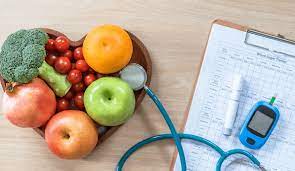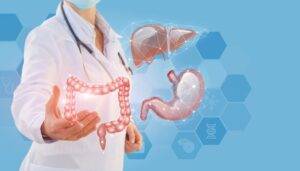It’s a chronic disease that occurs either when the pancreas doesn’t produce enough insulin or when the body can’t effectively use the insulin is a hormone that regulates blood glucose hyperglycemia, also called raised blood glucose or raised blood sugar, is a common effect of uncontrolled diabetes and over time leads to serious damage to many of the body’s system, especially the nerves and blood vessels.

As per data published by WHO, between 2000 and 2019, there was a 3% increase in age-standardized mortality rate. In lower-middle-income countries, the mortality rates increased by 13%.
Chronic diabetes conditions include type 1 and type 2 diabetes. Potentially reversible diabetes conditions including prediabetes and gestational happen during pregnancy. But it may go away after the baby is born.
Types of Diabetes-
Type 1 : It is thought to be caused by an autoimmune reaction (that body attack itself by mistake). This reaction stops your body from making insulin. Approximately 5-10% of the people who have type1. Symptoms of type1 often develop quickly. It’s usually diagnosed in children, teens and young adults. If you have type 1. you’ll need to take insulin every-day to survive. Currently no one knows how to prevent type 1.
Type 2 : With type 2, your body doesn’t use insulin well and can’t keep blood sugar at normal levels. About 90-95% of the people have type 2. It develops over many years and is usually diagnosed in adults (but more and more in children, teens and young adults). You may not notice any symptoms, so it’s important to get your blood sugar tested if you’re at risk.
Type 2 can be prevented or delayed with healthy lifestyle changes, such as:
-Loosing weight.
-Eating healthy food.
-Being active.
Gestational : It develops in pregnant women who have never had diabetes. If you have gestational, your baby could be at higher risk for health problems. It usually goes away after your baby is born. However, it increases your risk for type 2 later in life. Your baby is more likely to have obesity as a child or teen and develop type 2 later in life.
Prediabetes: With prediabetes, blood sugar levels are higher than normal, but not high enough for type 2 diagnosis. It raises your risk for type 2 diabetes, heart disease and stroke. But there’s a good news, if you have prediabetes “lifestyle change” can help you take healthy steps to reverse it.
Apart from the types stated above, a rare condition called “diabetes insipidus” is not related to mellitus, although it has a similar name. it’s a different condition in which your kidneys remove too much fluid from your body.
Every type of diabetes have different symptoms, causes and treatment. Some of the common symptoms, causes and treatment are listed below:
Symptoms:
Diabetes depends on how high your blood sugar is some people, especially if they have prediabetes or type 2 may not have symptoms. In type 1 symptoms tend to come on quickly and be more severe.
Some of the symptoms of Type 1 and type 2 diabetes are:
-Feeling more thirsty than usual.
-Urinating often.
-Losing weight without trying.
-Presence of ketones in the urine. Ketones are a byproduct of the breakdown and muscle and fat that happens when there’s not enough available insulin.
-Feeling tired and weak.
-Feeling irritable or having other mood changes. -Having blurry vision.
-Having slow-healing sores.
-Getting a lot of infections, such as gum, skin and vaginal infections.
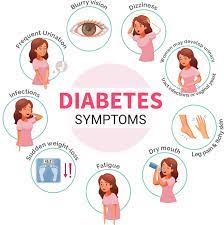
Type 1 can start at any age. But it often starts during childhood or teen years. Type 2, the more common type, can develop at any age. Type 2 is more common in people older than 40.
Causes:
To understand this, it’s important to understand how the body normally uses glucose.
How insulin works?
Insulin is a hormone that comes from gland behind and below the stomach (pancreas).
-The pancreas releases insulin into the blood stream.
-The insulin circulates, letting sugar enters the cells.
-Insulin lowers the amount of sugar in the bloodstream.
-As the blood sugar level drops, so does the secretion of insulin from the pancreas.
The role of glucose.
Glucose-a sugar is a source of energy for the cells that make up muscles and other tissues.
-Glucose comes from two major sources: food and liver.
-Sugar is absorbed into the bloodstream, where it enters cells with the help of insulin.
-The liver stores and makes glucose.
-When glucose levels are low, such as when you haven’t eaten in a while, the liver breaks down stored glycogen into glucose. This keeps your glucose level with a typical range.
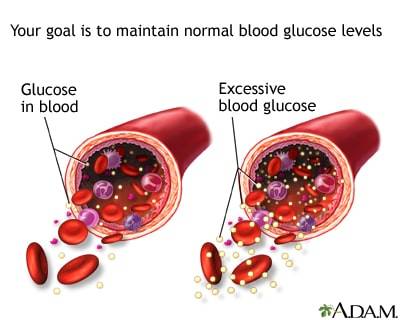
That exact cause of most type of diabetes is known. In all cases, sugar builds up in the bloodstream. This is because the pancreas doesn’t produce enough insulin. Both type 1 and type 2 may be caused by a combination of genetic or environmental factors. It is what those factors may be.
Risk Factor:
Family history may play a part in all types. Environmental factors and geography can add to the risk of type 1 . Sometimes family members of people with type 1 are tested for the presence of diabetes immune system cells (autoantibodies).
If you have these autoantibodies, you have an increased risk of developing type 1, but not everyone who has that antibodies develop diabetes.
Race or ethinicity, also may raise your risk of developing type 2. Although it’s unclear why certain people-including black, Hispanic, American, Indian and Asian American people-are at higher risk. Prediabetes, type 2 and gestational diabetes are more common in people who are overweight or obese.
Complication:
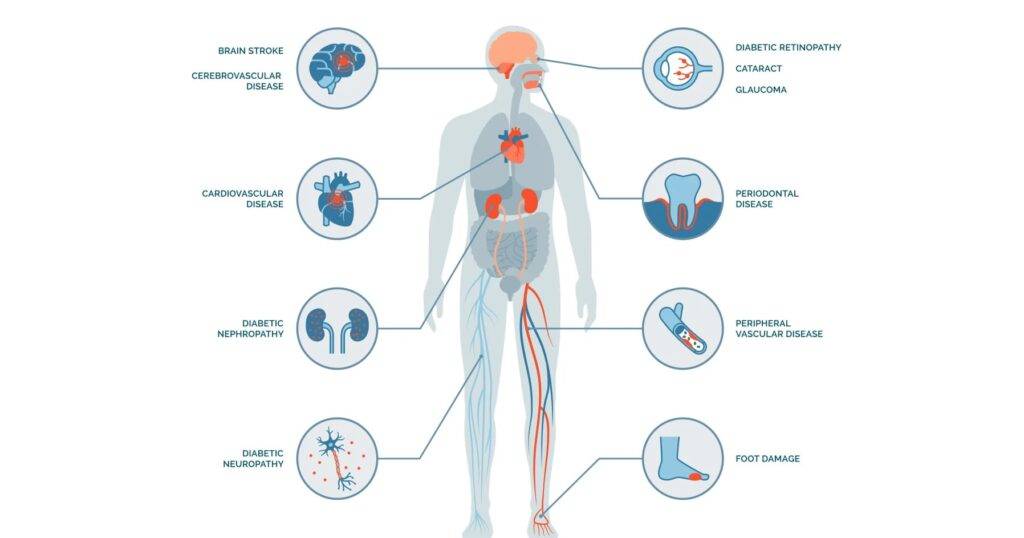
Long-term complications develop gradually. The longer you have diabetes and the less controlled your blood sugar- the higher the risk of complication. Eventually, diabetes complications may be disabling or even life-threatening. In-fact, prediabetes can lead to type 2 diabetes. Possible complication include:
-Heart and blood vessel (Cardiovascular)disease.
-Nerve damage(neuropathy).
-Kidney damage(nephropathy).
-Eye damage (retinopathy).
-Foot damage.
-Skin and mouth condition.
-Hearing impairment.
-Alzheimer’s disease.
-Depression.
Prevention from :
Type 1 can’t be prevented but the healthy lifestyle choices that help treat it, type 2 and gestational diabetes can also prevent them.
-Eat healthy food.
-Get more physical activity.
-Loose excess pounds.
Sometimes drugs are an option. Oral diabetes drugs such as metformin (Glumetza, fortamet and others) may lower the risk of type 2. But healthy lifestyle choices are important if you have prediabetes, have your blood sugar checked at least once a year to make sure you haven’t developed type 2 diabetes.
Ravi Worldwide Medicines: Buy any medicines online at low price/All kinds of Anti-Cancer drugs and Life-Saving Drugs/Retail & wholesale medicines
Ravi Worldwide Medicines Pvt. Ltd. is a Wholesale specialty Medicine Pharmaceutical Distributor & Trader for Life-saving drugs and rare medicines by condition. We Import/Export 5 Lakh+ products from 200+ Pharma Manufacturers across 180+ countries, serving for the last 30+ years.
We provide Online medicines anywhere in the World safe and secure.
Call us for more details:
Distributor and Exporter of All kinds of Anti-cancer medicines and life-saving drugs.
We delivered medicines to customers anywhere in the world. Kindly contact us, we are happy to help you.Business WhatsApp: +91-9994330921 Email:Ravi.raviworldwidemedicines@gmail.com
Web Link: https://raviworldwidemedicines.com/
About: https://raviworldwidemedicines.com/about-ravi-worldwide-medicines/
Contact: https://raviworldwidemedicines.com/contact-details/
